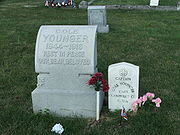
Lee's Summit Historical Cemetery
Encyclopedia
Lee’s Summit Historical Cemetery is a cemetery
in Lee's Summit, Missouri
. There are many local notable people resting here, including Nicholas B. Langsford, Dr. Pleasant Lea, William B. Howard, William S. Cowherd
, and former mayors from Lee’s Summit and surrounding areas. Civil War
veterans and several members of the Confederate guerrilla band known as Quantrill’s Raiders have also been laid to rest here, including Cole Younger.
 The most notable of all people interred at LSHC is Thomas Coleman Younger, better known as Cole Younger. Younger was born in Lee’s Summit in 1844 and killed his first man during a border skirmish serving as a Confederate soldier in the Civil War. He was 21 when the Civil War ended in 1865, and he returned home to join his ailing mother and three brothers. Cole and his brothers, Jim, John, and Bob, all joined the James Gang and lived the lives of outlaws, which led to the 25-year prison sentence they would serve at the Minnesota State Prison. Cole was released from prison and returned to Lee’s Summit to live the life of a “model citizen”. He died in 1916 with 11 bullets still embedded in his body. Cole was buried in lot #12, with his brothers Jim and Bob and his mother, Bursheba, also buried nearby.
The most notable of all people interred at LSHC is Thomas Coleman Younger, better known as Cole Younger. Younger was born in Lee’s Summit in 1844 and killed his first man during a border skirmish serving as a Confederate soldier in the Civil War. He was 21 when the Civil War ended in 1865, and he returned home to join his ailing mother and three brothers. Cole and his brothers, Jim, John, and Bob, all joined the James Gang and lived the lives of outlaws, which led to the 25-year prison sentence they would serve at the Minnesota State Prison. Cole was released from prison and returned to Lee’s Summit to live the life of a “model citizen”. He died in 1916 with 11 bullets still embedded in his body. Cole was buried in lot #12, with his brothers Jim and Bob and his mother, Bursheba, also buried nearby.
There are thousands of others who have made LSHC their final resting place. The remains of those who could not afford to purchase a family lot are buried in a potter’s field. Many of the influenza victims of 1918, infants, and slaves, whose headstones (if they had them) have long eroded away, are buried in this section of the cemetery. There are currently 20,000 grave sites sitting on 20 acres (80,937.2 m²).
Cemetery
A cemetery is a place in which dead bodies and cremated remains are buried. The term "cemetery" implies that the land is specifically designated as a burying ground. Cemeteries in the Western world are where the final ceremonies of death are observed...
in Lee's Summit, Missouri
Lee's Summit, Missouri
Lee's Summit is a city in the U.S. state of Missouri, and is contained within the counties of Jackson and Cass. As of the 2010 census found the population at 91,364 making it the sixth-largest city in the Kansas City Metropolitan Area and the sixth-largest city in Missouri...
. There are many local notable people resting here, including Nicholas B. Langsford, Dr. Pleasant Lea, William B. Howard, William S. Cowherd
William S. Cowherd
William Strother Cowherd was a Democratic Mayor of Kansas City, Missouri in 1892–1893 and Congressman from Missouri in 1897–1905....
, and former mayors from Lee’s Summit and surrounding areas. Civil War
American Civil War
The American Civil War was a civil war fought in the United States of America. In response to the election of Abraham Lincoln as President of the United States, 11 southern slave states declared their secession from the United States and formed the Confederate States of America ; the other 25...
veterans and several members of the Confederate guerrilla band known as Quantrill’s Raiders have also been laid to rest here, including Cole Younger.
History
The Lee’s Summit Historical Cemetery (LSHC) got its start in 1865 when William B. Howard donated the oldest addition of the cemetery (approximately two acres) to the Town of Strother, which later became incorporated and known as Lee’s Summit. Before this cemetery, there were numerous family cemeteries throughout the area. The second addition of the cemetery was surveyed in May 1875, and in April 1887, a third addition was added. Two additional acres were purchased from Mrs. William B. Howard in December 1889. The cemetery grew again in April 1907 when another 2 acres (8,093.7 m²) were added. Sidewalks were built along the cemetery in September 1915. In July 1931, the cemetery roads were graveled and then paved in September 1975. In July 2002, the original wrought iron sign was restored and placed at the southeast corner of the cemetery. This sign dates back to 1860 and once marked the entrance to the cemetery.
There are thousands of others who have made LSHC their final resting place. The remains of those who could not afford to purchase a family lot are buried in a potter’s field. Many of the influenza victims of 1918, infants, and slaves, whose headstones (if they had them) have long eroded away, are buried in this section of the cemetery. There are currently 20,000 grave sites sitting on 20 acres (80,937.2 m²).

